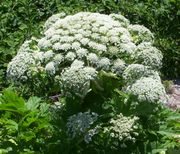 |
|
|
|
Fri, 19 Apr, 2024
|

|
|

Pay as you go
No monthly charges. Access for the price of a phone call
Go>
Unmetered
Flat rate dialup access from only £4.99 a month Go>
Broadband
Surf faster from just £13.99 a month Go> |
Save Even More
Combine your phone and internet, and save on your phone calls
More Info> |
This weeks hot offer
 24: Series 5
24: Series 5
In association with Amazon.co.uk £26.97 |
|
|
? Giant Hogweed |

|
| Scientific classification |
| Kingdom: |
Plantae
|
| Division: |
Magnoliophyta
|
| Class: |
Magnoliopsida
|
| Order: |
Apiales
|
| Family: |
Apiaceae
|
| Genus: |
Heracleum
|
| Species: |
H. mantegazzianum
|
|
|
|
|
|
|
|
Heracleum mantegazzianum
Sommier & Levier |
|
|
Giant Hogweed (Heracleum mantegazzianum), or Giant Cow-parsley, is a member of the family Apiaceae, native to the Caucasus Region and Central Asia.As its name indicates, it is characterized by its size and may grow 2-5m (rarely to 7 m) tall. Except for size, it closely resembles Common Hogweed (Heracleum sphondylium) or Garden Angelica (Angelica archangelica).It is further distinguished by a stout, dark reddish-purple stem and spotted leaf stalks that are hollow and produce sturdy bristles. Stems vary from 3-8 cm in diameter, occasionally up to 10 cm. The stem shows a purplish-red pigmentation with raised nodules. Each purple spot on the stem surrounds a hair, and there are large, coarse white hairs at the base of the leaf stalk. The plant has deeply incised compound leaves which grow up to 1-1.7 m in width.Giant Hogweed is a perennial with tuberous rootstalks which form perennating buds each year. It flowers from late spring to mid summer, with numerous white flowers clustered in an umbrella-shaped head that is up to 80 cm (2.5 ft) in diameter across its flat top.The plant produces flattened, 1cm long, oval dry seeds that have a broadly rounded base, and broad marginal ridges.The Giant Hogweed flowers from late spring to mid summer, and then produces numerous (between 1,500-100,000 seeds), large flattened elliptic dry seeds. Shoots die down in the fall. Tall stems mark its locations during winter.Many foreign plants were introduced to Britain in the 19th century, mainly for ornamental reasons. A few have become aggressively dominant, creating serious problems in some areas. It is now widespread throughout the British Isles especially along riverbanks. By forming dense strands they can displace native plants and reduce wildlife interests. It has also spread in the northeastern and northwestern United States.In the UK the Wildlife and Countryside Act 1981 makes it an offence to plant or cause Giant Hogweed to grow in the wild.Giant Hogweed is a phototoxic plant. Its sap can cause photodermatitis, skin inflammations when the skin is exposed to sunlight. Initially the skin colours red and starts itching. Then blisters form as in burns within 48 hours. They form black or purplish scars, which can last several years. Hospitalisation may become necessary. Presence of minute amounts of sap in the eyes, can lead to temporary or even permanent blindness. These reactions are caused by the presence of linear derivatives of furocoumarine in its leaves, roots, stems, flowers, and seeds. These chemicals can get into the nucleus of the epithelial cells, forming a bond with the DNA, causing it to die.
 Giant Hogweed (close-up)
Keep children away from this plant. Wear protective clothing when handling it if you dig plants; consider wearing eye protection. Chopping out the root is feasible, but may have to be done several times as the plant re-grows. Wash off exposed skin thoroughly with soap and water.Keep the plant mowed down during the summer to prevent seeds from maturing. Don't allow pieces of it to land on bare skin. Even after the parent plant is completely removed, the seeds left behind can come up, 7 or 8 years later. Ongoing monitoring is required. Removing the green growth will help to exhaust the root and will weaken the plant, so digging it out and chopping it is feasible.2,4-D, TBA, MCPA and dicamba will kill above ground parts but are reportedly not particularly effective on persistent rootstalks. Glyphosate (roundup) is considered the most effective herbicide and should be used cautiously around desirable species since it is nonselective. Application during bud stage and while the plant is actively growing is recommended by New York Cooperative Extension. |
Change Text Size:
[A]
[default]
[A] |




 |
|
|
|
|